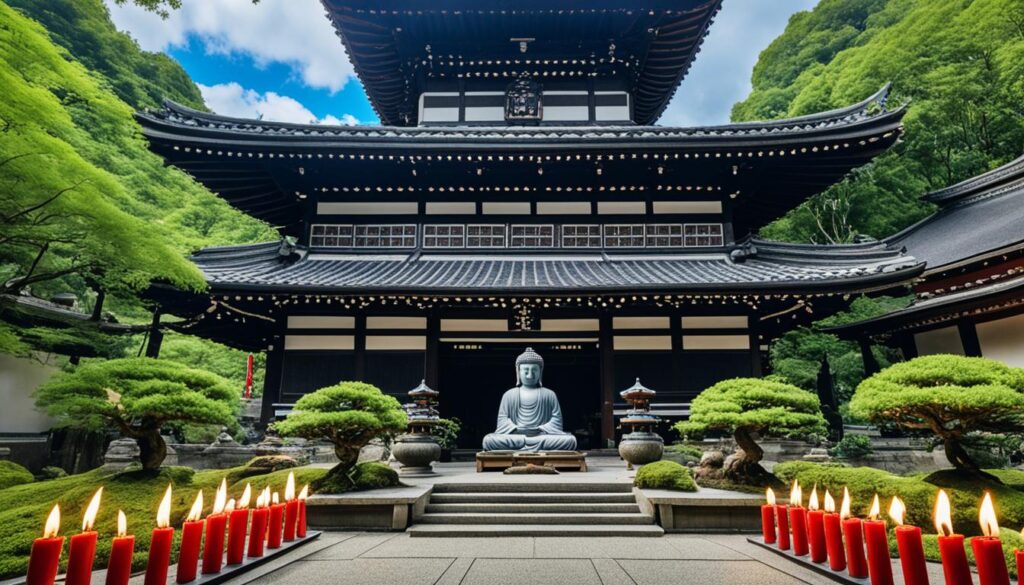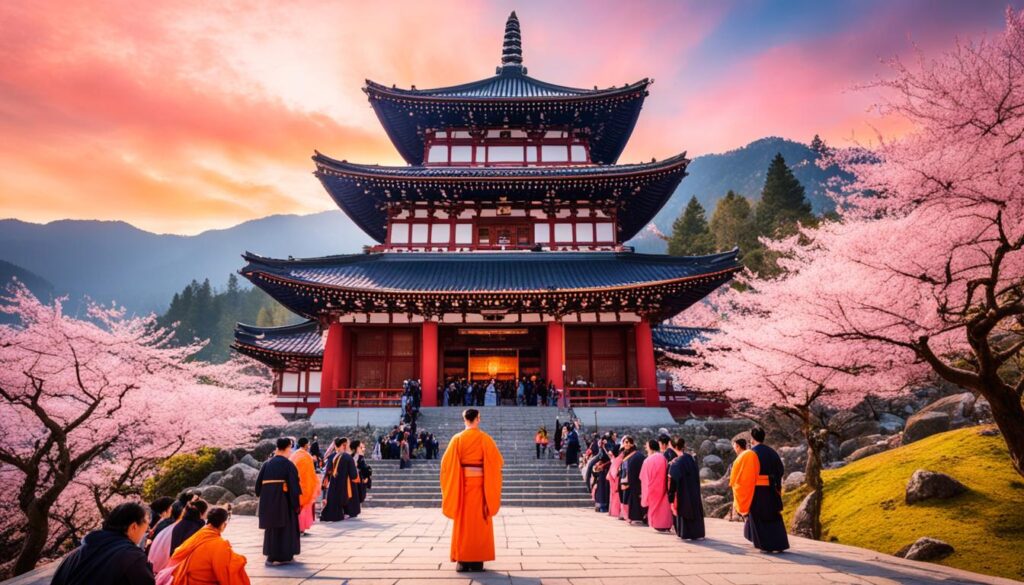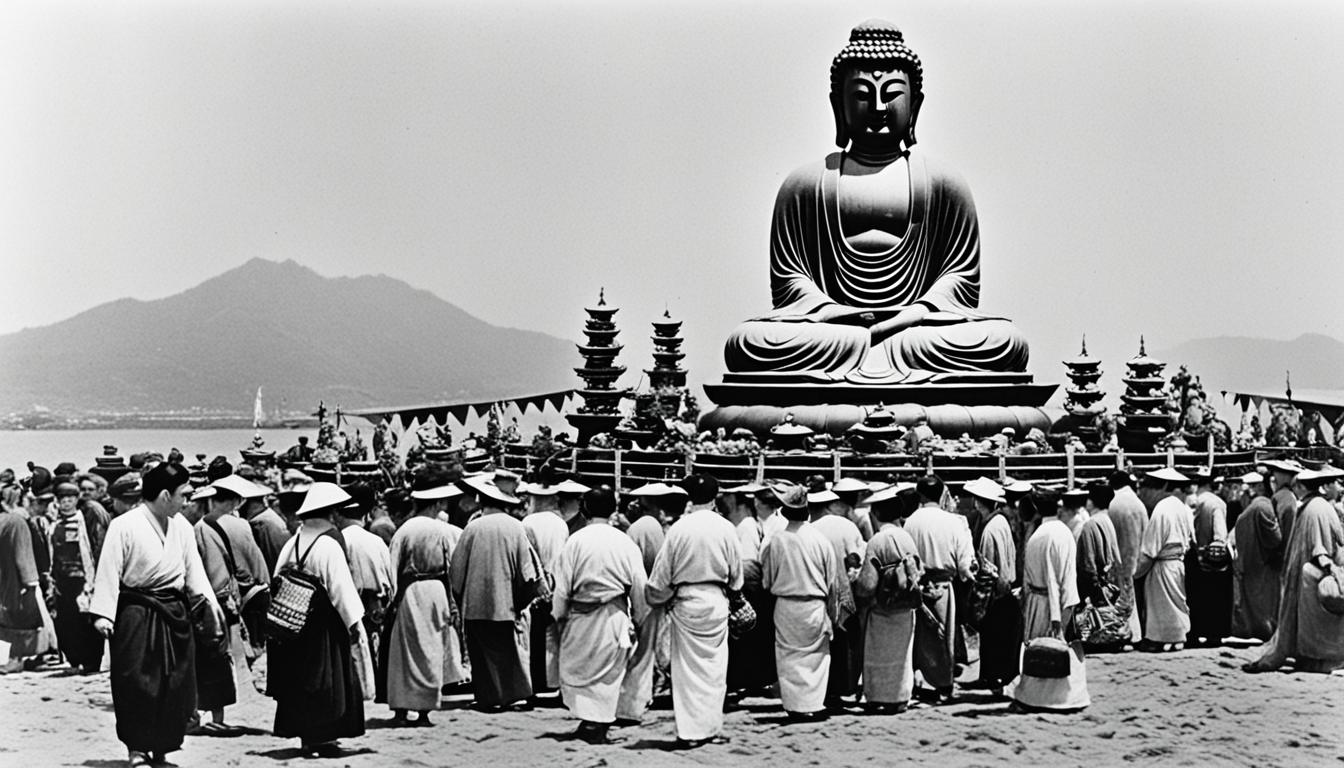Have you ever wondered when Buddhism first made its way to Japan? How did this influential religion, with its roots in India, find its place in the Land of the Rising Sun? The arrival of Buddhism in Japan is a captivating journey that unveils the cultural and historical interplay between different civilizations.
Key Takeaways:
- Buddhism was officially introduced to Japan in the 6th century CE, originating from China and Korea.
- The earliest recorded introduction of Buddhism to Japan was in 538, but there were likely earlier contacts and attempts to introduce it.
- The powerful Soga clan and Prince Regent Shotoku played significant roles in the spread and adoption of Buddhism in Japan.
- Buddhism initially influenced court nobles and the elite before spreading to other social strata.
- Throughout Japanese history, Buddhism has left an indelible mark on art, architecture, philosophy, and religious practices.
Buddhism in the Nara Period (710-784)
During the Nara Period in Japan, Buddhism experienced a period of significant growth and development. This era, which lasted from 710 to 784, was characterized by the establishment of kokubunji, national Buddhist temples, in every province. These temples served as centers of Buddhist practice and played a crucial role in the dissemination of Buddhist teachings throughout the country.
Emperor Shomu, a devout Buddhist, played a pivotal role in the support and promotion of Buddhism during this period. He embarked on ambitious construction projects, building grand temples and pagodas across Japan. These structures served as impressive symbols of the emperor’s devotion and commitment to Buddhism.
In addition to constructing temples, Emperor Shomu also introduced Buddhist scriptures from China, further enriching the religious landscape in Japan. These scriptures provided new insights and teachings that helped shape the beliefs and practices of Japanese Buddhists.
During the Nara Period, six major schools of Buddhism emerged and coexisted within the same temples. These schools were:
- Sanron
- Hosso
- Kegon
- Ritsu
- Kusha
- Jojitsu
Each school had its own unique teachings and philosophies, contributing to the diversity and development of Buddhism in Japan.

One of the most famous and significant temples of the Nara Period was Todai-ji. This temple, located in Nara, housed the imposing Great Buddha statue and served as the headquarters of the national Buddhist temples. The Great Buddha, also known as Daibutsu, stands at an impressive height of approximately 15 meters and is an iconic symbol of Japanese Buddhism.
| Temple | Location | Significance |
|---|---|---|
| Todai-ji | Nara | Housed the Great Buddha statue, served as headquarters of national Buddhist temples |
| Kofuku-ji | Nara | One of the Seven Great Temples of Nara, played a significant role in the spread of Buddhism |
| Horyu-ji | Nara | One of the oldest temples in Japan, renowned for its ancient wooden architecture and art treasures |
The Nara Period was characterized by tremendous national support of Buddhism, with the emperor actively promoting and encouraging its growth. The establishment of kokubunji temples and the coexistence of different Buddhist schools paved the way for the development of Buddhism as a major religious and cultural force in Japan.
Buddhism in the Heian Period (794-1185)
In the Heian Period, Buddhism continued to thrive and underwent significant developments. Two new schools of Buddhism, Tendai and Shingon, were introduced and became influential centers of Buddhist practice in Japan.
Tendai Buddhism
Tendai Buddhism was founded by Saicho, also known as Dengyo Daishi, on Mount Hiei. Saicho aimed to synthesize various Buddhist philosophical concepts and teachings into a cohesive system. One of the key beliefs emphasized in Tendai Buddhism is the idea of the equality of all beings in attaining enlightenment. Saicho advocated for the spread of Mahayana Buddhism and established a Mahayana ordination platform on Mount Hiei, which allowed practitioners from various regions to receive ordination.
Shingon Buddhism
Shingon Buddhism was established by Kukai, also known as Kobo Daishi, on Mount Koya. Kukai focused on esoteric Buddhism, teaching mystical practices involving mantras and mudras. Shingon Buddhism emphasizes the realization of one’s innate Buddha-nature through ritual practices and meditative techniques. Kukai’s teachings and practices attracted followers from different backgrounds, including court nobles, scholars, and monks.
The introduction of Tendai and Shingon Buddhism during the Heian Period expanded the religious landscape in Japan, offering practitioners diverse paths to spiritual awakening. These new schools of Buddhism influenced not only religious practices but also the cultural and artistic expressions of the time.
| Tendai Buddhism | Shingon Buddhism |
|---|---|
| Founded by Saicho on Mount Hiei | Established by Kukai on Mount Koya |
| Emphasized the equality of all beings in attaining enlightenment | Focused on esoteric Buddhism and mystical practices |
| Established a Mahayana ordination platform on Mount Hiei | Emphasized the realization of one’s innate Buddha-nature through ritual practices |
| Attracted court nobles, scholars, and monks | Brought together followers from different backgrounds |
Buddhism in the Kamakura Period (1192-1333)
The Kamakura Period ushered in a transformative era for Buddhism in Japan, bringing about significant changes and giving rise to new forms of practice. This period, characterized by the rise of a new military government, witnessed a shift in the status of Buddhism, as it became more accessible to the masses rather than being confined to the privileged classes.
Under the Kamakura shogunate, Buddhism gained widespread popularity and became the religion of the people. This marked a departure from the previous period, where Buddhism held strong influence primarily among the court nobles and elites. With the decline of the old court’s power, Buddhism took on a different role, providing solace and guidance to the common people.

During the Kamakura Period, two major Buddhist schools gained prominence: Pure Land Buddhism and Zen Buddhism. These schools offered different paths to salvation and resonated deeply with the changing aspirations and needs of the people.
Pure Land Buddhism, also known as Jodo Buddhism, provided a message of hope and salvation through faith. It emphasized the practice of reciting the name of Amitabha Buddha with unwavering devotion to be reborn in his Pure Land, a realm of ultimate enlightenment. The teachings of Pure Land Buddhism offered a sense of comfort and assurance to individuals seeking liberation from the cycle of birth and death.
Zen Buddhism, on the other hand, appealed to those seeking a more immediate and direct experience of enlightenment. Zen emphasized the practice of meditation (zazen) and the realization of one’s Buddha-nature in the present moment. Zen masters played a vital role in guiding practitioners to have direct insight into their true nature and awaken to their inherent wisdom.
Key Characteristics of Buddhism in the Kamakura Period:
- A shift from court patronage to the religion of the common people
- Rise of Pure Land Buddhism with an emphasis on faith and rebirth in Amitabha Buddha’s Pure Land
- Popularity of Zen Buddhism and the practice of meditation as a means to attain enlightenment
The Kamakura Period witnessed a dynamic transformation in the nature and practice of Buddhism in Japan. The accessibility of Buddhism to a wider audience through the rise of Pure Land and Zen Buddhism played a pivotal role in shaping the religious landscape and the spiritual lives of the Japanese people.
| Buddhist Schools | Key Teachings and Practices |
|---|---|
| Pure Land Buddhism (Jodo) | Rebirth in the Pure Land of Amitabha Buddha through faith and recitation of his name |
| Zen Buddhism | Meditation (zazen) and direct insight into one’s true nature for immediate enlightenment |
Buddhism in the Muromachi Period (1336-1573)
The Muromachi Period witnessed the emergence of the Ashikaga shogunate and the profound influence of Zen Buddhism. This era ushered in a golden age of Zen culture and arts, with practices such as the tea ceremony and suizen, or “blowing Zen,” gaining popularity.

The Muromachi Period was characterized by the construction of Zen temples and gardens, showcasing the Japanese people’s deep appreciation for simplicity, beauty, and mindfulness. Zen Buddhism, with its emphasis on the practice of meditation and direct experience of enlightenment, found integration into various aspects of Japanese culture and aesthetics.
The tea ceremony, also known as chanoyu, became a symbolic ritual that united aesthetics, spirituality, and social interaction. Influenced by Zen principles, this elaborate and deliberate practice sought to create a moment of mindfulness and tranquility through the preparation and serving of tea.
Suizen, or “blowing Zen,” was a musical practice that combined the art of playing traditional Japanese flute instruments, such as the shakuhachi, with the meditative aspects of Zen. By focusing on breath control and producing soulful melodies, practitioners aimed to reach a state of heightened awareness and self-transcendence.
Zen Temples and Gardens
The Muromachi Period saw the construction of Zen temples and gardens, which served as places of contemplation and meditation. These serene and meticulously designed spaces were often characterized by rock arrangements, carefully raked gravel patterns, and carefully placed vegetation to create a harmonious balance between nature and human intervention.
| Zen Temples and Gardens | Description |
|---|---|
| Ryoan-ji Temple | Famous for its Zen rock garden, Ryoan-ji is a renowned UNESCO World Heritage Site. The garden features an arrangement of fifteen carefully placed rocks on a bed of gravel, surrounded by moss and bordered by a simple wall. |
| Ginkaku-ji Temple | Also known as the Silver Pavilion, Ginkaku-ji is recognized for its aesthetics and beautiful gardens. The garden includes a sand mound called the “Sea of Silver Sand” and a moss garden known as the “Moss Garden of the Kogetsudai.” |
| Daisen-in Temple | Daisen-in is famous for its beautifully composed rock garden that depicts islands and waves. The garden reflects the subtle harmony and peacefulness associated with Zen Buddhism. |
The integration of Zen Buddhism into various aspects of Japanese culture during the Muromachi Period left a lasting impact, influencing the country’s art, architecture, and way of life. This period marked a significant chapter in the ongoing evolution of Buddhism in Japan.
Buddhism in the Edo Period (1603-1868)
During the Edo Period, Buddhism faced significant challenges as it came under the control of the powerful feudal Shogunate in Japan. This period marked a decline in the influence of Buddhism due to the government’s policies and actions.
One of the key developments during this time was the forced separation of Buddhism and Shinto, the indigenous religion of Japan. The government enforced strict regulations that suppressed Buddhist teachings and practices, limiting its influence over the population.
Despite these restrictions, Buddhism continued to have a significant impact on Japanese society and culture. While its influence may have diminished, Buddhism remained a vital part of Japanese history and tradition.
The Meiji Period, which followed the Edo Period, further marginalized Buddhism as the country underwent modernization and westernization. The government, as part of its response to this changing landscape, sought to distance itself from Buddhism and promote a new national identity.
However, even with the decline in influence, Buddhism in the Edo Period served as a testament to the resilience and endurance of the religion in Japan. It played a crucial role in shaping the country’s culture, art, and philosophical teachings.

Despite the controlled environment and the separation enforced by the shogunate, Buddhism continued to be practiced and preserved by dedicated believers. The teachings and values of Buddhism provided solace and guidance to individuals seeking spiritual enlightenment and personal growth.
In the table below, we outline key factors that influenced Buddhism in the Edo Period:
| Factors | Impact on Buddhism |
|---|---|
| Control by the Shogunate | Resulted in a decline in Buddhism’s influence and enforced regulation of the religion. |
| Forced Separation of Buddhism and Shinto | Limited Buddhist teachings and practices, contributing to a decrease in the religion’s reach. |
| Response of the Meiji Period | Further marginalized Buddhism as Japan underwent modernization and promoted a new national identity. |
Despite these challenges, Buddhism persevered and continued to shape the cultural fabric of Japan. Its values of compassion, mindfulness, and wisdom remain influential to this day.
Conclusion
Buddhism has left an indelible mark on Japanese culture and history. Introduced to Japan in the 6th century CE, it has influenced various aspects of Japanese society, including art, architecture, philosophy, and religious practices. The teachings of Buddhism, emphasizing mindfulness and compassion, have provided profound insights for personal and societal harmony in Japan.
Throughout different periods, the impact of Buddhism on Japanese culture has been both strong and fluctuating. It has served as a guiding force in shaping Japanese aesthetics, with Buddhist principles reflected in the serene simplicity of Zen gardens and the meticulous beauty of tea ceremonies. Additionally, Buddhism has contributed to the development of Japanese architecture, as seen in the magnificent temples and pagodas found across the country.
While Buddhism’s influence on Japanese society may have wavered at times, it remains an integral part of the country’s cultural heritage. Millions of believers in Japan continue to practice Buddhism in various sects, finding solace and meaning in its teachings. As Japan navigates the challenges of the modern world, Buddhism’s enduring wisdom serves as a source of inspiration and guidance.
FAQ
When was Buddhism introduced to Japan?
Buddhism was officially introduced to Japan in the 6th century CE, with the earliest recorded introduction being in 538 when an image of the Buddha was presented to Emperor Kimmei by the ruler of Baekje, a Korean kingdom. However, there were likely earlier contacts and attempts to introduce Buddhism to Japan through immigrants and sailors.
How did Buddhism spread in Japan?
Buddhism initially had a strong influence on court nobles and the elite in Japan. It was further promoted by Prince Regent Shotoku, who declared Buddhism as the official religion during the reign of Empress Suiko. Buddhism gradually spread to other social strata in Japan and was supported by the construction of national Buddhist temples in every province during the Nara Period.
What were the major schools of Buddhism in Japan during the Nara Period?
During the Nara Period, the major schools of Buddhism in Japan were the Sanron, Hosso, Kegon, Ritsu, Kusha, and Jojitsu schools. These schools coexisted in the same temples and contributed to the development of Buddhism in Japan.
What were the significant developments in Buddhism during the Heian Period?
In the Heian Period, two new schools of Buddhism were introduced to Japan: Tendai and Shingon. Saicho founded the Japanese Tendai school, emphasizing the belief in the equality of all beings in attaining Buddhahood. Kukai established the Shingon school, focusing on esoteric Buddhism and teaching mystical practices. These new schools attracted court nobles, scholars, and monks, becoming influential centers of Buddhism in Japan.
How did Buddhism change during the Kamakura Period?
The Kamakura Period marked a significant shift in Buddhism as it became more accessible to the masses rather than being limited to the privileged classes. Pure Land Buddhism and Zen Buddhism gained popularity during this period, offering salvation through faith or meditation practices. Buddhism became the religion of the people, and it provided solace and guidance to the common people.
What role did Zen Buddhism play in the Muromachi Period?
The Muromachi Period saw the rise of the Ashikaga shogunate and Zen Buddhism. Zen culture and arts flourished during this time, with practices such as the tea ceremony and suizen (blowing Zen) becoming popular. Zen temples and gardens were built, reflecting a deep appreciation for simplicity, beauty, and mindfulness. Zen Buddhism became integrated into various aspects of Japanese culture and aesthetics.
How did Buddhism fare during the Edo Period?
During the Edo Period, Buddhism was controlled by the feudal Shogunate, leading to a decline in its influence. The government enforced a separation between Buddhism and Shinto, resulting in the suppression of Buddhist teachings and practices. Despite this decline, Buddhism continued to play a significant cultural and historical role in Japan.
How has Buddhism impacted Japanese culture and history?
Buddhism has had a profound impact on Japanese culture and history. It has shaped various aspects of Japanese society, including art, architecture, philosophy, and religious practices. Buddhism’s teachings of mindfulness, compassion, and addressing modern challenges have provided insights for personal and societal harmony in Japan. While its influence has fluctuated throughout different periods, Buddhism remains an integral part of Japanese cultural heritage and continues to be practiced by millions of believers in various sects across the country.

